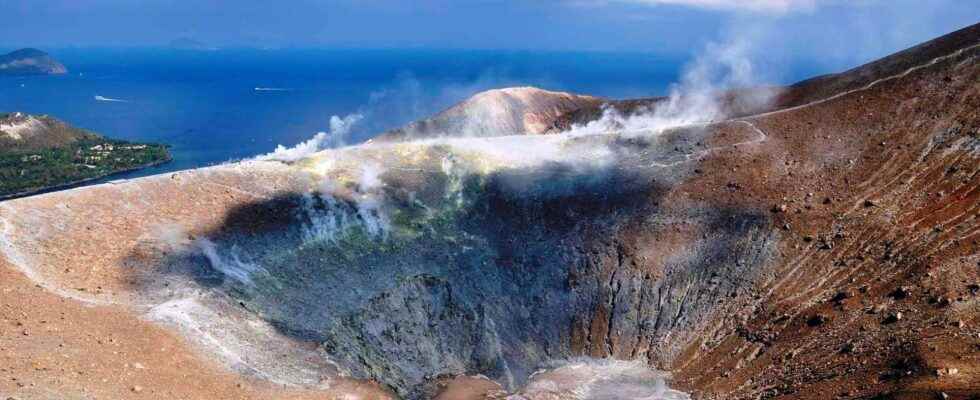Since September 2021, the surveillance systems of theIstituto nazionale di geofisica e vulcanologia Italian have recorded a significant variation of certain volcanological signals detected at Vulcano, in particular those related to the activity of the hydrothermal system that feeds the fumaroles of the crater of La Fossa. The alert level on the island has changed from green to yellow and it is now closed to tourists while a red zone for the partial evacuation of the population – at night – has been established.
North of Sicily, in the Tyrrhenian Sea, are the Aeolian Islands still called Lipari Islands after the name of the main island. This volcanic archipelago is literally mythical since it is associated with Aeolus, the master of winds of the odyssey of Homer. The famous Athenian historian Thucydides already spoke of it in these terms: “ The so-called Aeolus islands belong to the Liparians who are colonists of Cnidus. They live in one of them, which is not large, called Lipara; they leave there to cultivate the others, Didymè, Strongylè and Hiéra. The people of the region think that in Hiéra Héphaïstos has its forges, because one sees a lot of flames going up at night and smoke of them during the day. “
For us today, Strongylè is called Stromboli and Hiéra is called Vulcano and it is not surprising because Héphaïstos for the Romans of Antiquity, it is the Vulcan god. Vulcano is also at the origin of the word volcano, for obvious reasons.
Fumarole activity, solid sulfur deposits (alpha and beta phase) and liquids, filmed in 2018 on the edge of the Fossa crater, in Vulcano (Aeolian Islands, Sicily, Italy). © Ludovic Leduc
What is less known to the general public is that for volcanologists, the eruptions of the last 1880s were used to define in the first place the activity eruptive of a volcano making what is henceforth called an eruption vulcanian. We owe the definition of this type of rash and their name to seismologist and Italian volcanologist Giuseppe Mercalli who had witnessed these volcanic activities. Mercalli is also at the origin of a classification of earthquakes according to the damage they cause and it is therefore complementary to that of Richter, better known, based on theenergy released.
Increasingly hot and important fumaroles
Vulcano, like almost all the Aeolian Islands, is very touristy because until now and for more than a century you could climb on the edges of its central crater, the Fossa, and admire its fumarole fields with its magnificent deposits of sulfur. It is often the first contact for enthusiasts with active volcanoes, followed by another pilgrimage also in the footsteps of volcanologists French Haroun Tazieff, Maurice and Katia Krafft on Stromboli.
But in recent months, Vulcano has increasingly worried about changes in the geochemical and geothermal parameters of fumaroles, as well as seismic and deformation parameters of the volcano. At the beginning of October, the mayor of Lipari had already severely restricted access to the top of the crater of La Fossa.
The fumarole activity on Vulcano can be increased by the rains but if we compare that of the middle of October 2021 with that of 2018 in the previous video above, we begin to see a clear difference signaling an increase in degassing. © INGVvulcani
About a month ago, volcanologists recalled that the last major eruption dates back to 1890 and that La Fossa is not an extinct volcano but only asleep, variations in geochemical and geophysical parameters not necessarily implying a resumption of the eruptive activity are normal. Better still, the variations already observed, an increase in the temperatures of fumaroles and volumes emitted, had already occurred during the 1980s. There was no need to panic and really fear a new eruption … but one could not exclude it (one can find an exhibition of the history recent eruptive of Vulcano with this link).
At the beginning of October 2021, the head of the Wind Turbine Observatory, the volcanologist Mauro Coltelli, explains the increase in the activity of the Fossa, recalling that the last violent eruption dates back 130 years. To understand the rest of his explanations, click on the white rectangle at the bottom right. The Italian subtitles should then appear. Then click on the nut to the right of the rectangle, then on “Subtitles” and finally on “Translate automatically”. Choose “French”. © AMnotizieVideo
Carbon dioxide emissions multiplied by 6
Still, on November 18, 2021, a press release fromIstituto nazionale di geofisica e vulcanologireported that four geochemical stations to measure the flow of CO2 soil and CO concentration2 in L’air, which are added to the existing network, and a Multigas station for CO detection2 and SO2 had been installed. At the same time, six new seismic stations were added on the island of Vulcano as well as two gravimeters with continuous acquisition of periodic gravity measurements on the cone from La Fossa. Other new devices have joined them, such as a new thermal camera monitoring the fumarole zone inside the La Fossa crater.
In this video, the significant increase in fumarole activity on Vulcano is very clear and spectacular. © Passione Fotografia, Angelo Gitto
The situation worsened and volcanologists measured a factor 6 increase in emissions of gas carbonic compared to the normal average, because it is not less than 480 tons of CO2 who are now released every day.
Residents have already demonstrated respiratory problems, and there are already fears of deaths so that an exclusion zone leading to 250 people to move has been established while the island’s access to tourists has been removed for at least a month.
The red zone containing shops and restaurants remains open during the day, but residents are not allowed to stay in their homes between 11:00 p.m. and 6:00 a.m. It is easier to be caught by gas at night deleterious.
Interested in what you just read?
.
fs11
